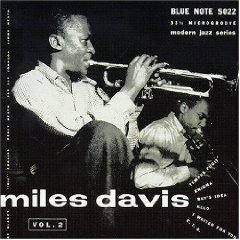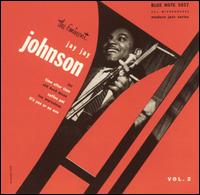
Clifford Benjamin Brown was an American jazz trumpeter. He died at the age of 25 in a car accident, leaving behind four years' worth of recordings. He was also a composer of note: his compositions "Sandu", "Joy Spring", and "Daahoud" have become jazz standards.

Miles Davis Volume 2 refers to two separate but related entities. The first is a Miles Davis studio album released by Blue Note Records as a 10-inch LP, as BLP 5022 in 1953. The six tracks from this LP plus five alternate takes were released on CD in 1990 and remastered with restored artwork in 2001.

Miles Davis Volume 1 refers to two separate but related entities. The title was originally used for the first time in a pair of compilation albums of recordings made by Miles Davis in 1952, 1953 and 1954, released in 1956 as BLP 1501 on the Blue Note Records label.

A Night at Birdland Vol. 1 is a 1954 release by jazz artist Art Blakey, and a quintet which featured Clifford Brown, Lou Donaldson, Horace Silver and Curly Russell. It was first released by Blue Note Records as a 10" LP and then as a 12" LP containing material from the second 10" album. It was reissued for the first time on CD in 1987 with two additional tracks, previously released on a 2 LP Compilation in 1975 called Live Messengers (BN-LA473-J2). The CD was reissued again in 2001 as an "RVG Edition" remastered by Rudy Van Gelder with the tracks in a different order. The 1987 CD used the second 12" LP cover, the 2001 CD revived the original 10" LP cover.

A Night at Birdland Vol. 2 is a 1954 release by jazz drummer Art Blakey, and a quintet which featured Clifford Brown, Lou Donaldson, Horace Silver and Curley Russell. It was first released by Blue Note Records as a 10" LP. Two years later, the three 10" LPs in the set were reissued as 2 12" LPs; the 12" Vol. 2 is BLP 1521. Two of the three tracks of the original 10" Vol. 2 were included in the 12" Vol. 1. The 12" Vol. 2 incorporates all three tracks from the 10" A Night at Birdland Vol. 3 plus a previously unreleased alternate take of "Quicksilver."

A Night at Birdland Vol. 3 may refer to two different jazz albums, both of which contain live material recorded by the Art Blakey Quintet at Birdland on February 21, 1954. The first is the third album in the original 10" series released in 1954 by Blue Note Records. The three original 10" albums were repackaged as two 12" LPs in 1956, with all of the tracks from the original 10" Vol. 3 being included on the 12" Vol. 2.
This is the discography of Blue Note Records, the American jazz record label. Most of the records were studio recordings produced by Alfred Lion or Francis Wolff. The two main series were '1500', which ran from 1955 to 1958, and '4000', which ran c.1958 to 1972. The 'BN-LA' series followed during the 1970s: this series contained many compilations and reissues in addition to new studio albums.

Horace Silver and the Jazz Messengers is a 1956 repackage of 1954 and 1955 releases by jazz pianist Horace Silver with drummer Art Blakey as well as Hank Mobley on saxophone, Kenny Dorham on trumpet, and Doug Watkins on bass. By the time of this repackage, this quintet had named themselves the Jazz Messengers, and the band name on the re-release reflected that. These recordings helped establish the hard bop style. Scott Yanow on Allmusic describes it as "a true classic". Originally released as an LP, the album has subsequently been reissued on CD several times.
This is a discography of the Jazz trombonist J. J. Johnson.

The Amazing Bud Powell, Vol. 2 is a studio album by jazz pianist Bud Powell, released on Blue Note Records in 1954, featuring a session Powell recorded with George Duvivier on bass and Art Taylor on drums at the WOR Studios in New York, on August 14, 1953. It was remastered in 2001 by Rudy Van Gelder and reissued as part of Blue Note's RVG Edition series. Prior to this, on all releases bar the first, the album also contained a number of tracks from sessions originally on The Amazing Bud Powell, Vol. 1. The version of the album included on the second disc of The Complete Blue Note and Roost Recordings, a 4 disc box set, is that from the first CD release in 1989.

The Eminent Jay Jay Johnson, Vol. 2 is the title of a 1954 Blue Note Records recording by American jazz trombonist J. J. Johnson. It is also the title used by Blue Note for two different-but-related compilation/re-issues from 1955 and 1989 (CD).

Young Man with a Horn is the second studio album of Miles Davis, released as a 10-inch mono LP recorded and released by the Blue Note label in 1952. The album title is presumably a reference to the 1950 film Young Man with a Horn.

Memorial Album is an album by American jazz trumpeter Clifford Brown composed of tracks recorded at two sessions in 1953 and originally released as a 12" LP on the Blue Note label in September 1956. Apart from a few obscure recordings, the album represents the first tracks recorded under Brown's leadership.

Miles Davis Quartet is a 10 inch LP album by Miles Davis, released in 1954 by Prestige Records. The first four tracks that comprise Side 1 were recorded at New York's WOR Studios, on May 19, 1953. The last three, heard on Side 2, were recorded nearly a year later, at New York's Beltone Studios, on March 15, 1954.

Miles Davis, Vol. 3 is a 1954 10 inch LP album by Miles Davis. It consists of the third and last of three sessions recorded for Blue Note Records. Several years later, Davis would once again record at Blue Note, but as a sideman on Cannonball Adderley's Somethin' Else.

Horace Silver Trio and Art Blakey - Sabu is a 1955 compilation album, featuring, primarily the Horace Silver Trio, but also includes two percussion-centric tracks featuring drummer Art Blakey and conga player Sabu. The tracks on this album are compiled from three sessions which were Silver's first as a leader. Originally released as an LP, it has subsequently been reissued on CD several times, including additional tracks not present on the original LP.
This is the discography for American jazz musician Lou Donaldson.

Jay Jay Johnson with Clifford Brown is a 1953 Blue Note Records album by American jazz trombonist J. J. Johnson, recorded on June 22, 1953. The album was re-issued on CD in 1989 as The Eminent Jay Jay Johnson, Volume 1, with three alternate take 'bonus tacks' from the same 1953 recording session. Five of the six original tracks were included also in a 1955 12 inch LP re-issue/compilation (also) titled, The Eminent Jay Jay Johnson, Volume 1.

The Eminent Jay Jay Johnson, Vol. 3 is a 1955 Blue Note 10" LP of a small group led by American jazz trombonist J. J. Johnson.
This is the discography of Bud Powell. Most of these recordings are listed by the year they were recorded rather than year released.
















